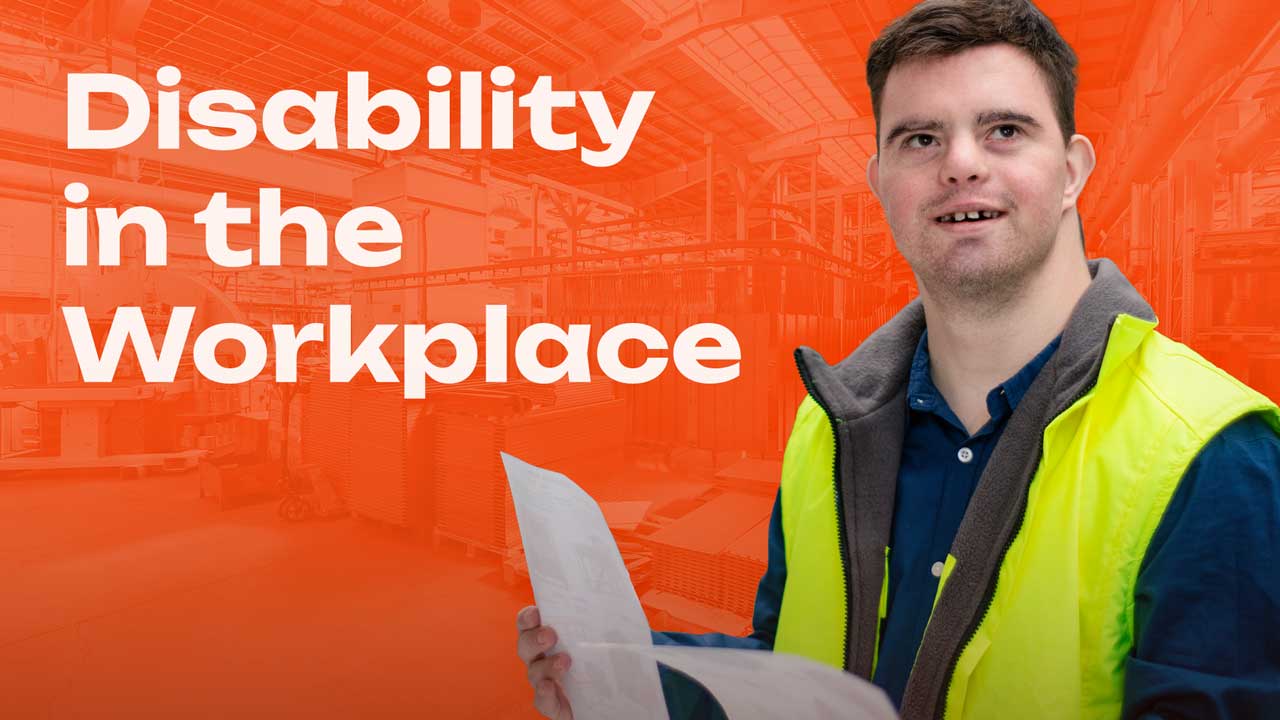Over 2.7 million people of working age in Australia are living with disability (Australian Disability Network 2024).
Unfortunately, people living with disability are twice as likely to be unemployed as those without disability (AIHW 2024).
What is Disability?
Under the Equal Opportunity Act 2010, the term disability encompasses:
- A physical, psychological or neurological condition
- Temporary or permanent illness
- Injury.
(VEOHRC 2019)
It’s vital that your workplace allows a person living with disability to work just as someone without disability would be able to.
Many of the restrictions faced by people with disability arise because of society’s outdated and narrow ways of thinking about disability. A refined model of thinking could conceive of disability as the result of an interaction between a non-inclusive society and its individuals (PWDA 2024).

Inclusive Language
Language is powerful. Historically, the terms we have used to talk about disability have ranged anywhere from insensitive to outright insulting.
The following provides examples of inclusive language:
- Often, people with disability have a strong preference for either person-first (e.g. ‘person with cerebral palsy’) or identify-first language (e.g. ‘autistic person’). It’s important to respect each individual’s preferences about the language used about them.
- Use ‘person without disability’ - don’t use ‘able-bodied’ or ‘normal’.
- People are not ‘bound’ by wheelchairs - the term wheelchair-bound should be avoided as it may cause offence. ‘Person who uses a wheelchair’ is preferred.
- Avoid terms such as ‘suffering’ and ‘inflicted by/with’ to describe someone living with disability. Make an effort to remove emotion from the description. For example, ‘Sam has epilepsy’.
(PWDA 2021)
For more information and more examples of inclusive language, see People with Disability Australia’s guide to language about disability and Ausmed’s Article on Communicating Effectively With People With Disability.
Under the Disability Discrimination Act 1992, It is a breach of Australian law to discriminate against someone in the workplace based on their disability (AHRC 2014).
In July 2008, Australia signed on to the UN Convention on the Rights of Persons with Disabilities.
The aim of this Convention is to:
'Promote, protect and ensure the full and equal enjoyment of all human rights and fundamental freedoms by all persons with disabilities, and to promote respect for their inherent dignity.'
(AHRC 2013)
Employees living with disability are protected from discrimination in all stages of employment under the Disability Discrimination Act 1992, for example, in the case of:
- Recruitment: advertising, interviewing and other selection processes.
- Workplace terms and conditions: rates of pay, working hours and leave entitlements.
- Dismissal: including demotion and retrenchment.
(AHRC 2014)

Direct and Indirect Discrimination
Discrimination in the workplace against people with a disability can occur in a way that is overt or subtle.
- Direct discrimination: The situation in which a person is acted toward less favourably, or is not given the same opportunities as others solely because of their disability.
- Indirect discrimination: Less obvious. It occurs when employers enact conditions, practices or requirements that might seem as though they treat everyone in the same way but, in fact, disadvantage people living with disability.
(AHRC 2014)
An example of this would be requesting that a person who is deaf attend meetings in which no Auslan interpreter is provided. By not being able to understand what is being said during the meeting they are clearly being disadvantaged.
Disability Employment in the Healthcare Industry
In 2017, the Building Employer Demand Research report highlighted that Australian employers have room for improvement when it comes to hiring people living with disability. It revealed that more than half of Australian businesses in the healthcare, social and education services sectors overlook applicants living with disability (Choahan 2018).
The report is based on findings from the Australian Department of Social Services, which examined employer attitudes towards hiring people living with disability. It was discovered that only 58% of employers were currently employing someone living with a disability (Choahan 2018).
Alarmingly, 38% of employers in the healthcare, social and education services industry who were surveyed consider employing someone living with disability to be ‘a step in the unknown’ (Choahan 2018).
The healthcare industry should be leading this movement, given that it is an industry that interacts with this community so closely (Chair of RACGP’s Disability Specific Interests Network, Bob Davis, quoted by Choahan 2018).
Accessibility In the Workplace
Reflect on whether your work environment is open, inclusive and accessible to people living with disability. Is there anything that could potentially impede a person living with disability?
It is reasonable to request that your workplace improves accessibility in the following areas:
- Access to the workplace (design, architecture and equipment)
- IT and software
- Providing disability training for every worker (online or face-to-face)
- Engaging with accessibility suppliers
- Documents, websites and email messages
- Communications, media and events.
(Queensland Government 2023; AHRC 2014)
Workplaces should:
- Express a clear commitment to improved access and inclusion
- Be able to demonstrate a strategic plan to address access and inclusion
- Engage with people living with disability to find out what kind of adjustments they may require to perform their roles
- Have in place a clear and effective process for recording and implementing workplace adjustments
- Ensure that all staff, including people living with disability, are able to access opportunities and career development equal to those without disability
- Training and events in the workplace should be completely accessible to people living with disability
- Always use inclusive language
- Have physically accessible premises
- Provide information in accessible formats such as braille, large text or audio
- Have an accessible website, intranet and other digital assets
- Have recruitment and selection processes that are inclusive of people living with disability
- Have policies to ensure that their suppliers and partners are accessible to people living with disability
- Have measures to prevent workplace discrimination in alignment with the Disability Discrimination Act 1992
- Have programs or initiatives in place to increase the confidence of, and actively encourage, people living with disability
- Have fair and effective policies in place for sharing and monitoring information about disabilities.
(Australian Disability Network 2018)

Conclusion
While these adjustments may assist someone living with disability, it is worth noting that 88% of people living with disability have reported that they do not require additional support from their employer to be able to work (AIHW 2024).
This suggests that the primary reason for underemployment is persistent stigma at a society level, rather than any actual difficulties or restrictions to employing people living with disability.
Employers can access a range of resources and supports on the JobAccess website to assist them in hiring a person with a disability.
The benefits of hiring people living with disability are numerous. Beyond the well-known benefits of a diverse workforce, studies have shown that workers with disability have higher job retention, better attendance, increased productivity and fewer work health and safety incidents (Australian Disability Network 2023).
Test Your Knowledge
Question 1 of 3
True or false: Person-first language should always be used when talking about people living with disability.
Topics
Further your knowledge
 Free
Free
 Free
FreeReferences
- Australian Disability Network 2018, Workplace Considerations for Inclusion of People with Disability, Australian Disability Network, viewed 28 November 2024, https://web.archive.org/web/20200313185415/https://www.and.org.au/articles.php/37/workplace-considerations-for-inclusion-of-people-with-disability
- Australian Disability Network 2023, Business Benefits of Employing People with Disability, Australian Disability Network, viewed 28 November 2024, https://australiandisabilitynetwork.org.au/join-us/why-hire-people-with-a-disability/benefits
- Australian Disability Network 2024, Disability Statistics, Australian Disability Network, viewed 28 November 2024, https://www.and.org.au/resources/disability-statistics/
- Australian Human Rights Commission 2013, United Nations Convention on the Rights of Persons with Disabilities (UNCRPD), Australian Government, viewed 28 November 2024, https://humanrights.gov.au/our-work/disability-rights/united-nations-convention-rights-persons-disabilities-uncrpd
- Australian Human Rights Commission 2014, Disability Discrimination, Australian Government, viewed 28 November 2024, https://humanrights.gov.au/sites/default/files/GPGB_disability_discrimination.pdf
- Australian Institute of Health and Welfare 2024, People with Disability in Australia, Australian Government, viewed 28 November 2024, https://www.aihw.gov.au/reports-data/health-conditions-disability-deaths/disability/overview
- Choahan, N 2018, ‘Healthcare Employers can Improve in Hiring People with Disability, New Report Shows’, newsGP, 22 August, viewed 28 November 2024, https://www1.racgp.org.au/newsgp/professional/healthcare-employers-has-room-to-improve-in-hiring
- People with Disability Australia 2021, PWDA Language Guide: A Guide to Language About Disability, PWDA, viewed 28 November 2024, https://pwd.org.au/wp-content/uploads/2021/12/PWDA-Language-Guide-v2-2021.pdf
- People with Disability Australia 2024, Social Model of Disability, PWDA, viewed 28 November 2024, https://pwd.org.au/resources/models-of-disability/
- Queensland Government 2023, Disability Inclusive Workplaces, Queensland Government, viewed 28 November 2024, https://www.forgov.qld.gov.au/employment-policy-career-and-wellbeing/culture-and-inclusion/disability-inclusive-workplaces
- Victorian Equal Opportunity and Human Rights Commission 2019, Disability and Employment: Reasonable Adjustments, Victoria State Government, viewed 28 November 2024, https://www.humanrights.vic.gov.au/for-individuals/disability-and-the-workplace/
 New
New 
